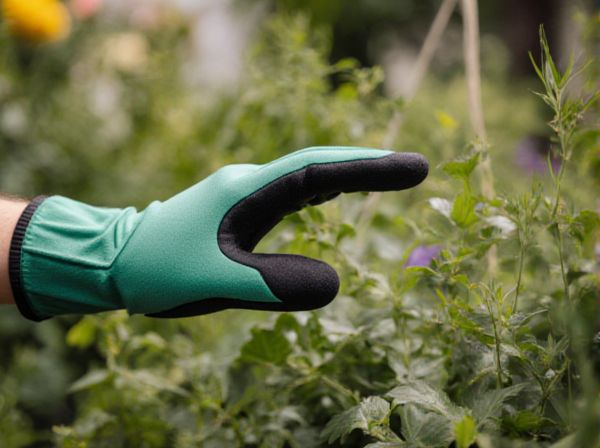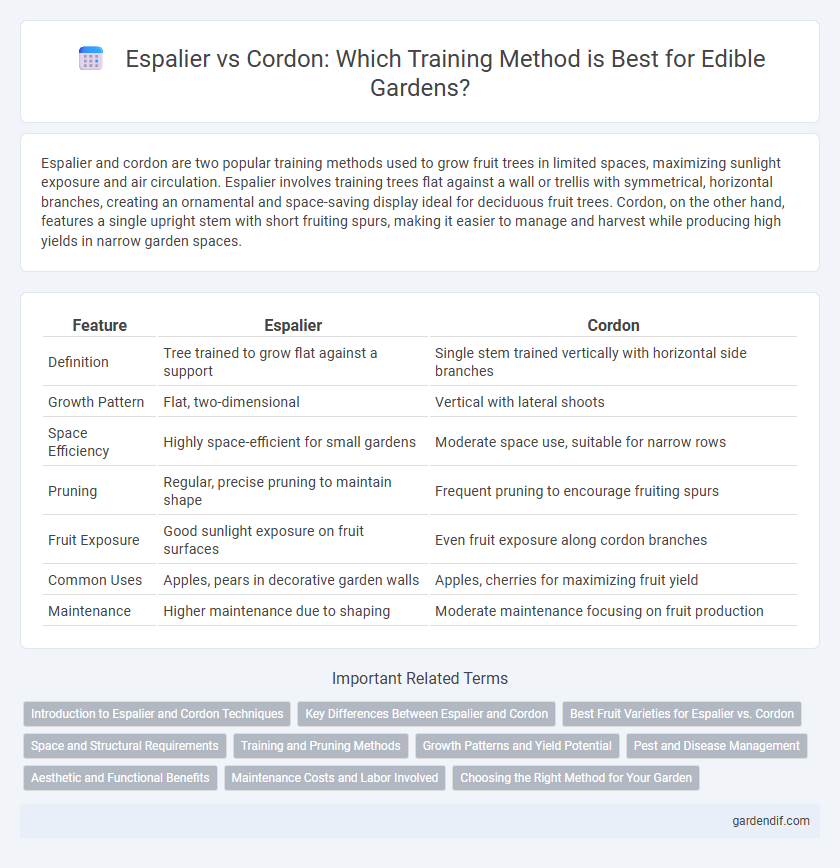
Espalier vs Cordon Illustration
Espalier and cordon are two popular training methods used to grow fruit trees in limited spaces, maximizing sunlight exposure and air circulation. Espalier involves training trees flat against a wall or trellis with symmetrical, horizontal branches, creating an ornamental and space-saving display ideal for deciduous fruit trees. Cordon, on the other hand, features a single upright stem with short fruiting spurs, making it easier to manage and harvest while producing high yields in narrow garden spaces.
Table of Comparison
| Feature | Espalier | Cordon |
|---|---|---|
| Definition | Tree trained to grow flat against a support | Single stem trained vertically with horizontal side branches |
| Growth Pattern | Flat, two-dimensional | Vertical with lateral shoots |
| Space Efficiency | Highly space-efficient for small gardens | Moderate space use, suitable for narrow rows |
| Pruning | Regular, precise pruning to maintain shape | Frequent pruning to encourage fruiting spurs |
| Fruit Exposure | Good sunlight exposure on fruit surfaces | Even fruit exposure along cordon branches |
| Common Uses | Apples, pears in decorative garden walls | Apples, cherries for maximizing fruit yield |
| Maintenance | Higher maintenance due to shaping | Moderate maintenance focusing on fruit production |
Introduction to Espalier and Cordon Techniques
Espalier and cordon techniques shape fruit trees to maximize space and sunlight exposure while enhancing fruit production. Espalier involves training branches in symmetrical patterns against a flat surface, ideal for walls or fences. Cordon focuses on a single main stem with short lateral branches, promoting manageable growth and easier harvesting in tight garden spaces.
Key Differences Between Espalier and Cordon
Espalier and cordon are two distinctive pruning techniques used for training fruit trees, with espalier featuring multiple horizontal tiers of branches trained against a flat surface, maximizing space efficiency and sun exposure. Cordon involves a single main stem with short fruiting spurs regularly pruned to encourage lateral fruit production, ideal for narrow spaces like fences or walls. The primary difference lies in espalier's architectural, decorative framework versus cordon's simpler, vertical growth habit emphasizing ease of maintenance and fruit harvesting.
Best Fruit Varieties for Espalier vs. Cordon
Best fruit varieties for espalier include apples, pears, and figs, which adapt well to the flat, two-dimensional growth pattern. For cordon training, cherries, plums, and peaches perform exceptionally due to their single-stem structure and open growth habit. Selecting varieties with strong spur or bud development enhances fruit production in both espalier and cordon training systems.
Space and Structural Requirements
Espalier fruit trees require a sturdy framework or trellis for training branches along horizontal wires, maximizing vertical growing space ideal for small gardens. Cordon trees, trained as a single upright stem with fruiting spurs, demand less structural support, making them suitable for narrow spaces or container growing. Both methods optimize space but espalier structures offer greater yield potential per square foot due to extensive branch exposure.
Training and Pruning Methods
Espalier training involves guiding fruit trees to grow flat against a support, using regular pruning to maintain horizontal branches that maximize sunlight exposure and air circulation. Cordon training focuses on a single upright stem with minimal lateral branches, requiring selective pruning to encourage fruiting spurs and manage tree height. Both methods enhance fruit production efficiency but differ in structural design and pruning frequency.
Growth Patterns and Yield Potential
Espalier fruit trees grow flat against a support, optimizing space with horizontal branches that enhance sunlight exposure, leading to a high yield in limited areas. Cordon training involves a single main stem with short fruiting spurs, promoting early fruit production and easier maintenance. Both methods improve airflow and reduce disease risk, but espalier typically offers higher yields per square foot due to its extensive branching pattern.
Pest and Disease Management
Espalier fruit trees offer better air circulation and sunlight exposure, reducing the risk of fungal diseases compared to cordon training, which can create denser foliage prone to pests. Pest management in espalier systems benefits from easier access for inspection and application of treatments, while cordon-trained trees may require more intensive pruning to manage pest habitats. Both methods demand vigilant monitoring, but espalier's open structure generally supports more effective and sustainable pest and disease control.
Aesthetic and Functional Benefits
Espalier and cordon techniques both enhance garden aesthetics by creating structured, visually appealing fruit trees that maximize space efficiency. Espalier training produces flat, decorative patterns against walls or fences, offering architectural beauty and increased sunlight exposure for better fruit ripening. Cordon growth emphasizes single, upright stems that simplify pruning and harvesting while promoting higher fruit yield per square meter.
Maintenance Costs and Labor Involved
Espalier training requires higher maintenance costs and more labor due to the need for regular pruning, tying, and monitoring to maintain the desired flat, two-dimensional growth against a support. Cordon systems generally involve less intensive maintenance since the single stem structure requires simpler pruning but may still need periodic training and inspections. Choosing between espalier and cordon depends on balancing the initial setup complexity with ongoing care expenses and labor availability.
Choosing the Right Method for Your Garden
Espalier and cordon are both effective training methods for growing fruit trees in limited spaces, with espalier involving a flat, two-dimensional framework against walls or fences, and cordon featuring a single main stem trained upright or angled. When choosing the right method, consider your garden's size, sunlight exposure, and desired plant maintenance level; espalier suits decorative, space-saving applications while cordon is ideal for producing high yields in narrower areas. Selecting the appropriate training system enhances fruit production, simplifies pruning, and maximizes garden aesthetics.
Espalier vs Cordon Infographic

 gardendif.com
gardendif.com